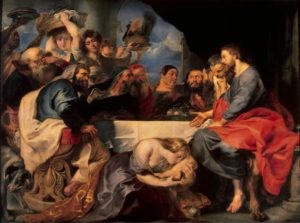 I am happy to announce that my paper entitled, “The Beautified Feet of Jesus: The Isaianic Renarrativization of Synoptic Tradition in Luke 7:36-8:1,” has been accepted for presentation in the Synoptic Gospels program unit for the 2019 Annual Meeting of the Society of Biblical Literature in San Diego in November. I will also be presenting an early version of the paper at the 2019 Upper Midwest Regional Meeting of the SBL in Minneapolis next month. The title and abstract are as follows:
I am happy to announce that my paper entitled, “The Beautified Feet of Jesus: The Isaianic Renarrativization of Synoptic Tradition in Luke 7:36-8:1,” has been accepted for presentation in the Synoptic Gospels program unit for the 2019 Annual Meeting of the Society of Biblical Literature in San Diego in November. I will also be presenting an early version of the paper at the 2019 Upper Midwest Regional Meeting of the SBL in Minneapolis next month. The title and abstract are as follows:
“The Beautified Feet of Jesus: The Isaianic Renarrativization of Synoptic Tradition in Luke 7:36-8:1”
The tradition of ‘the woman with the ointment’ as it is transmitted in the synoptic gospels survives to us in two substantially different iterations (Mark 14:3-9; Matt 26:6-13; Luke 7:36-50). The Matthean iteration shares the same substantial form from Mark, taking place at the end of Jesus ministry before his passion, in Bethany in Simon the Leper’s house immediately preceding Jesus’ betrayal by Judas, and the woman pouring the alabastar jar of oil on Jesus’ head as a kind of cryptic anointing for burial. The Lukan iteration of this tradition has been narratively recast as a scene taking place during his Galilean preaching ministry, in Simon the Pharisee’s house, and the woman pouring the oil on Jesus’ feet, he then forgiving her sins (Luke 7:36-50). There have been many scholarly explanations offered for the drastic difference in application of this tradition in the Gospel of Luke. This paper seeks to provide a further model that suggests the author renarrativizes the ‘woman with the ointment’ tradition in service of their wider narrative project in portraying Jesus as the Isaianic prophet whose “beautiful feet” brings the good news of the kingdom of God, intentionally echoing Isa 52:7 (cf. Luke 8:1). At the close of the Lukan version, Jesus declares the woman’s faith “saved” her (σωτηρία), instructs her to “go in peace” (εἰρήνη) (7:50), immediately followed by Jesus going “through the cites and villages, preaching and announcing the good news of the kingdom of God” (εὐαγγελίζω) (8:1), all the essential themes likewise drawn from Isa 52:7. This thesis will be argued from a careful reexamination of the Lukan iteration of the tradition in its immediate narrative context as well as providing further supporting evidence drawn from the employment of Isaiah elsewhere in the Lukan narrative.
I look forward to presenting this paper as I have been thinking about this text for quite some time. This study will have implications for how we understand Lukan redaction, Luke’s use of scripture, Luke’s use of Mark, narrative and source criticism of the synoptic gospels, the synoptic problem more generally, and even providing a source for elements of the Johannine reception of the tradition. It will be interesting to see what conversations end up taking place during the allotted time for Q&A at the end of the session.




